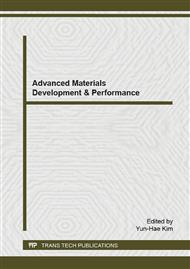p.267
p.271
p.277
p.287
p.291
p.295
p.302
p.306
p.311
Influence of Alkali Concentration on Morphology and Tensile Properties of Abaca Fibers
Abstract:
Abaca, also known as Manila hemp, is native to the Philippines, where it is grown as a commercial crop. It belongs to the Musasea family and is cultivated for ropes and fibers. The abaca fiber is a natural fiber with highest cellulose content. In this study, the effects of alkali treatments on mechanical properties and microstructure of abaca fibers are discussed. Abaca fibers were soaked in the aqueous solution of sodium hydroxide at the concentration from 3 to 15wt% for 5 minutes, and subsequently subjected to tensile tests and observations by scanning electron microscopy (SEM) to assess morphological changes caused by the alkali treatment. Fourier transform-infrared spectroscopy analysis demonstrated that the treatment led to the gradual removal of lignin and hemicelluloses from the abaca fibers. The cellulose crystallinity of abaca fibers was analyzed by an X-ray diffraction method. SEM images revealed that the lumen size decreased and shrunk with increasing alkali concentration. The tensile strength of the alkali-treated abaca fibers was higher than that of the untreated ones. The Young’s modulus increased with increasing alkali concentration up to 7wt% and then decreased. However, the strain at break decreased below 7wt% and then increased. The lumen size started to decrease from 7wt% alkali concentration.
Info:
Periodical:
Pages:
302-305
Citation:
Online since:
June 2015
Authors:
Keywords:
Price:
Сopyright:
© 2015 Trans Tech Publications Ltd. All Rights Reserved
Share:
Citation:


